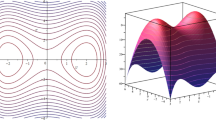Abstract
Using the method of continuous extension with respect to a parameter we develop a method of constructing the load trajectory of a structure having both limit points and bifurcation points. The method is applicable for the systems of nonlinear algebraic equations that describe the family of extremals that minimize the value of the total potential strain energy of the structure, and makes it possible to find all the branches of the load trajectory emanating from a bifurcation point and extend the solution along any of them. The method is based on the fact that the eigenvectors of the augmented Jacobian of the system of equations in the extended space of variables that correspond to zero eigenvalues on the main branch of the load trajectory are bifurcation vectors and form the active subspace of solutions of the equations of the extension. Meanwhile the other eigenvectors form the passive subspace that contains the extension vector with respect to the main branch of the load. As a result the entire process of computing the extension vector of the solution at any point of the load trajectory reduces to determining the eigenvectors of the augmented Jacobian of the original system of nonlinear algebraic equations, identifying them according as they belong to the active or passive subspace, and forming the extension vector of the solution using them and analytic relations
Similar content being viewed by others
Literature Cited
M. M. Vainberg and V. A. Trenogin,Theory of Branching of Solutions of Nonlinear Equations [in Russian], Nauka, Moscow (1969).
I. I. Vorovich and V. F. Zipalova, “On the solution of nonlinear boundary-value problems of the theory of elasticity by the method of passing to a Cauchy problem,”Prikl. Mat. Mekh. 29, No. 5, 894–901 (1965).
E. I. Grigolyuk and E. A. Lopanitsyn, “On the method of continuous extension with respect to a parameter,”Dokl. Ross. Akad. Nauk,335, No. 5, 582–585 (1994).
E. I. Grigolyuk and V. I. Mamai, “On methods of reducing a nonlinear boundary-value problem to a Cauchy problem,” in:Applied Problems of Strength and Plasticity [in Russian], Gor'kii State University Press (1979), pp. 3–19.
E. I. Grigolyuk and V. I. Shalashilin, “On some forms of the method of extension with respect to a parameter in nonlinear problems of the theory of elasticity,”Zh. Prikl. Mekh. Teoret. Fiz., No. 5, 158–162 (1980).
E. I. Grigolyuk and V. I. Shalashilin, “The method of extension with respect to a parameter in problems of nonlinear strain of rods, plates, and shells,”Usp. Mekh.,4, No. 2, 89–122 (1981).
E. I. Grigolyuk and V. I. Shalashilin,Problems of Nonlinear Strain [in Russian], Nauka, Moscow (1988).
Ya. M. Grigorenko and A. P. Mukoed,Computer Solution of Nonlinear Problems of the Theory of Shells [in Russian], Vishcha Shkola, Kiev (1983).
V. I. Gulyaev, V. A. Bazhenov, and E. A. Gotsulyak,Stability of Nonlinear Mechanical Systems [in Russian], Vishcha Shkola, L'viv (1982).
D. F. Davidenko, “On the approximate solution of systems of nonlinear equations,”Ukr. Mat. Zh.,5, No. 2, 196–206 (1953).
I. P. Erugin,Implicit Functions [in Russian], Leningrad State University Press (1956).
M. A. Krasnosel'skii, G. M. Vainikko, P. P. Zabreiko, and Ya. B. Rutitskii, and V. Ya. Stetsenko,Approximate Solution of Operator Equations [in Russian], Nauka, Moscow (1969).
V. I. Shalashilin, “Optimization of the extension parameter of the solution of the equations of nonlinear strain of elastic systems,” in:Statics and Dynamics of Flexible Systems [in Russian], Nauka, Moscow (1987), pp. 81–104.
M. Fujikake, “A simple approach to bifurcation and limit point calculation,”Int. J. Num. Math. Eng.,21, No. 1, 183–191 (1985).
G. W. Hunt and K. A. J. Williams, “Closed-form and asymptotic solutions for an interactive buckling model,”J. Mech. Phys. Solids,32, No. 2, 101–118 (1984).
W. T. Koiter, “Elastic stability and post-buckling behaviour,” in:Proceedings of the Symposium on Nonlinear Problems, R. E. Langer, ed., University of Wisconsin Press (1963), pp. 257–175.
I. Kubor, “Nonlinear deformation and buckling of shells weakened by holes of complex curvilinear configurations,” in:Collapse: Buckling of Structures. Theory and Practice, Symposium, London, 1982, Cambridge University Press (1983), pp. 395–408.
P. Samuels, “Bifurcation and limit point instability of dual eigenvalue third-order systems,”Int. J. Sol. Struct.,16, No. 8, 743–756 (1980).
J. M. T. Thompson and G. W. A. Hunt,A General Theory of Elastic Stability, London (1973).
J. M. T. Thompson and G. W. A. Hunt, “Towards a unified bifurcation theory,”J. Appl. Math. Phys.,26, 581–603 (1975).
G. A. Thurston, “Continuation of Newton's method through bifurcation points,”Trans. ASME,E36, No. 3, 425–430 (1969).
Additional information
Translated fromMatematychni Metody ta Fizyko-Mekhanichni Polya, Vol. 41, No. 1, 1998, pp. 35–46.
Rights and permissions
About this article
Cite this article
Grigolyuk, E.I., Lopanitsyn, E.A. Extension of the solution of nonlinear equations in the neighborhood of a bifurcation point. J Math Sci 97, 3796–3804 (1999). https://doi.org/10.1007/BF02364916
Received:
Issue Date:
DOI: https://doi.org/10.1007/BF02364916




